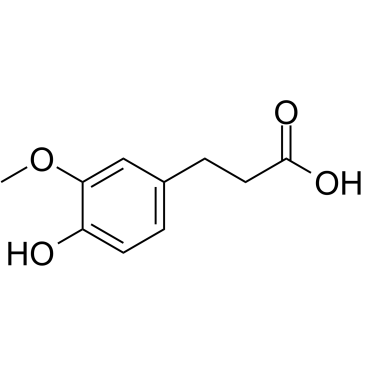Dihydroferulic acid |
| Catalog No.GC38280 |
Dihydroferulic acid (Hydroferulic acid) is one of the main metabolites of curcumin and antioxidant/radical-scavenging properties with an IC50 value of 19.5 μM.
Products are for research use only. Not for human use. We do not sell to patients.

Cas No.: 1135-23-5
Sample solution is provided at 25 µL, 10mM.
Dihydroferulic acid (Hydroferulic acid) is one of the main metabolites of curcumin and antioxidant/radical-scavenging properties with an IC50 value of 19.5 μM. Dihydroferulic acid is a metabolite of human gut microflora as well as a precursor of vanillic acid[1][2].
Uptake of hydroxycinnamic acids by control, organic anion transporter 1 (OAT1), OAT2, OAT3, and OAT4 over expressing 293H cells. In 293H control cells, there was significant uptake of Dihydroferulic acid. The uptake of Dihydroferulic acid is also enhanced ~2-fold in the OAT1-expressing cells[3].
Assessing the influence of an 11 weeks intervention with a resistant starch-enriched whole grain diet (HI-RS-WG, 25% RS) compared to a WG control diet (LOW-RS-WG, 6.9% RS) on serum profile of polyphenols (PPs) in 20 Zucker Diabetic Fatty rats. Five PPs were identified and quantified in serum samples of rats belonging to both intervention groups. HI-RS-WG rats had 2.6 folds higher serum concentrations of total PPs than LOW-RS-WG rats. An explorative data reduction approach, based on the Principal Component Analysis identified two principal components related to the gut microbiota fermentation and food intake, respectively. Results showed that the abundance of hippuric acid and Dihydroferulic acid in HI-RS-WG rats was explained by the stronger gut microbiota fermentation in those rats than in LOW-RS-WG rats[4].
[1]. Deters M, et al. Different curcuminoids inhibit T-lymphocyte proliferation independently of their radical scavenging activities. Pharm Res. 2008 Aug;25(8):1822-7. [2]. Beck JJ, et al. Fungicidal activities of dihydroferulic acid alkyl ester analogues. J Nat Prod. 2007 May;70(5):779-82. [3]. Wong CC, et al. Interaction of hydroxycinnamic acids and their conjugates with organic anion transporters and ATP-binding cassette transporters. Mol Nutr Food Res. 2011 Jul;55(7):979-88. [4]. Paola Vitaglionea, et al. Gut fermentation induced by a resistant starch rich whole grain diet explains serum concentration of dihydroferulic acid and hippuric acid in a model of ZDF rats. Journal of Functional Foods. 53 (2019): 286-291.
Average Rating: 5 (Based on Reviews and 23 reference(s) in Google Scholar.)
GLPBIO products are for RESEARCH USE ONLY. Please make sure your review or question is research based.
Required fields are marked with *




















